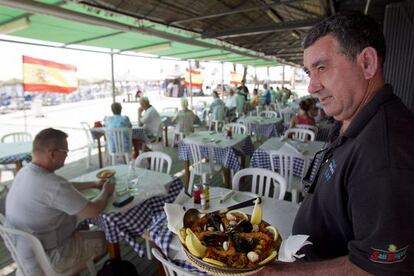The chefs' top 'chiringuitos'
Ferran Adrià and other big names choose their favorite beach bars


Every summer body lathered in sunblock and caked with salt needs a rest at some point. The moment when stomachs start complaining but nobody feels like cooking is the moment when the beach bars - the popular chiringuitos - get busy. The time has come for an ice-cold beer, a soft drink or a glass of wine and a quick bite to eat before taking that siesta away from the noise and the merciless sun of the early afternoon.
An al fresco meal of a rice dish, fresh fish just in from the market, a salad or some canned food can really spice up the solemn informality of summer, as can the smell of food cooking slowly but surely over the coals wafting over the boardwalk.
Informal, somewhat hippy, improvised, seasonal... the convenience of the chiringuitos has built its foundations on traditional Spanish cuisine - so much so that many of today's great avant-garde chefs find themselves fascinated by the authenticity of these small eateries that pop up on every corner of the Spanish coast.
From Galicia to the Balearics, from Cantabria to Andalusia, from Catalonia to Valencia to the Basque Country, the familiar Spanish beach bar - always there for the summer reveler at any time between breakfast and late night - has exerted an influence over the language, the identity and the personality of internationally renowned chefs.
Many avant-garde chefs are fascinated by the authencity of these small eateries
Take a look, for instance, at Ferran Adrià, whose chiringuito of choice is Escrivá, in Barcelona: "elBulli, as a matter of fact, used to be a chiringuito," he notes about the humble origins of what was to become the world's best restaurant for over a decade. Adrià owes a lot to chiringuito culture, including "the lack of formality, the cheekiness, the absence of pomposity."
If elBulli went through that metamorphosis, other eminent chefs such as Quique Dacosta dream of having their own chiringuito, albeit a modern one, of the type found in Ibiza: "Open until dawn, breakfast optional."
"I have often had breakfast at chiringuitos in Dénia. For those of us who grew up around there, we consider it normal," he says.
It is not difficult to imagine that morning moment when the coffee machine starts to bubble and the freshly baked buns are brought in, as the seagulls cry overhead. This is the meeting point for early risers who have already jogged several kilometers along the beach, couples looking dazed after a night of outdoor drinking, night owls back from some endless party and seeking something solid for their stomachs before hitting their beds... A good chiringuito works at full steam during the summer months, and is open nearly 24 hours.
But Dacosta's idea of a beach bar is rather modern: "Don't be fooled - you work like a slave, but you provide a crucial service to the holidaymaker and help create lots of pleasure," he asserts. His ideal chiringuito would be something like the Blue Marlin in Ibiza, which serves everything from Asian food to freshly caught fish to burgers in a chilled-out setting. Of course there are also the bad ones - establishments that were shut down because they violated coastal laws or lacked the necessary municipal permits.
elBulli, as a matter of fact, used to be a chiringuito," says Ferran Adrià
Manuel de la Osa, owner of the critically acclaimed Las Rejas restaurant in Las Pedroñeras, Cuenca, waxes nostalgic about a place called La cigarrilla, in Águilas in Murcia. But since that chiringuito is no more, he suggests any beach bar in Tamariu, on the Costa Brava, to eat some good mussels.
Although it is in the very nature of the chiringuito to be temporary, historical records of them do exist. A pioneering place in Sitges in the 1940s was the first to be described with the popular term, by the journalist César González Ruano. Before that, they were known as kioskets or merenderos , and their proprietors persecuted as though they were traveling salesmen. Slowly a tradition took root, however. Historians say their origins can be found in Cuba.
It would be rare indeed, however, to find grilled sardines in tropical chiringuitos, at least the way they are done in Málaga, al espeto ("on the skewer"). This particular dish has had a strong influence on the cuisine of Dani García and his celebrated Calima restaurant. "I have never understood why so little value is awarded to them. The work of an espetero is as careful and creative as that of a churrero [a person who makes deep-fried churro pastries]."
As if that were not enough, the classic chiringuito offers healthy food: fresh fish served simply, vegetables for a salad...
"Food is barely modified, it comes straight from the land and the sea and on to your plate," says García.
"That's what I believe in and not those chiringuitos with san jacobos [a dish similar to chicken cordon bleu]. We can accept rice, but a chiringuito that serves shrimp cocktail is just not a chiringuito."







































